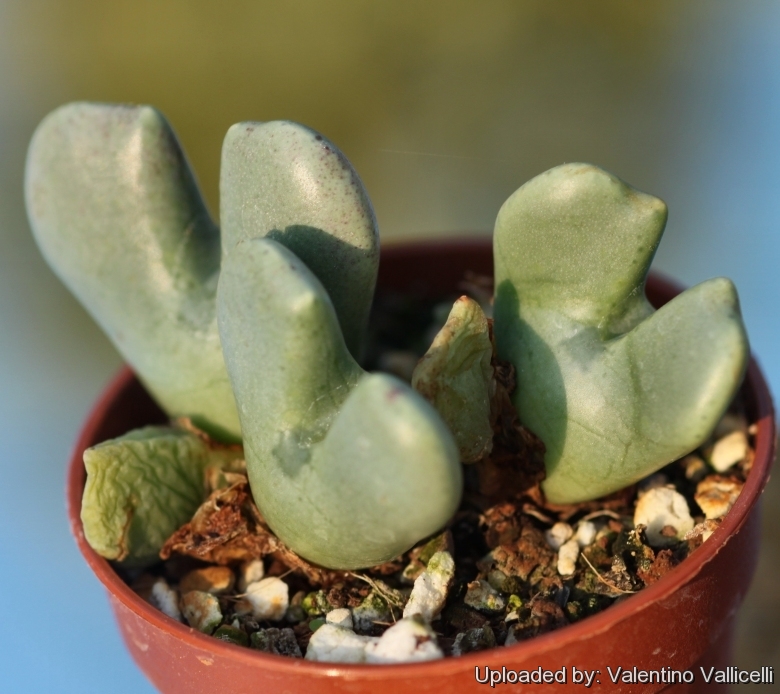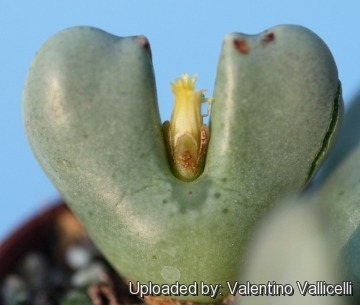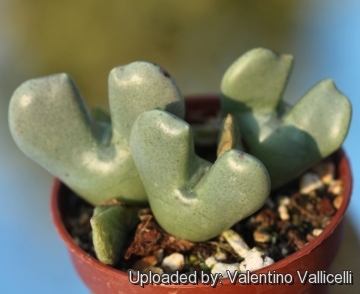Accepted Scientific Name: Conophytum quaesitum var. rostratum (Tischer) S.A.Hammer
Gen. Conophytum 261 1993 S.A.Hammer

Conophytum rostratum (Conophytum quaesitum var. rostratum) Photo by: Valentino Vallicelli
Gamkab.
Origin and Habitat: Gariep centre, Little Namaqualand, Northern Richtersveld (South Africa) and southern Namibia.
Habit and ecology: Conophytum quaesitumSN|25116]]SN|25116]] var. rostratum grows at high altitude in a harsh semi-desert region. It is usually found on step slopes in shaded rock crevices on quartz and gneiss. The rich succulent flora of the area comprising Pelargonium dasyphyllum, Sarcocaulon crassicauleSN|19559]]SN|19559]], just to cite some of the more common. There are no known threats to the taxon, primarily because of the inaccessibility of its habitat.
Synonyms:
See all synonyms of Conophytum quaesitum
Common Names include:
ENGLISH: sphaeroids, conos, cone plants, dumplings, button plants
AFRIKAANS (Afrikaans): polvygie, vaalbekkies, knopies
Description: Conophytum quaesitumSN|25116]]SN|25116]] var. rostratum is a dwarf almost stemless, succulent, distinguished from the type species for its beak-like lobes. Plants are caespitose and forms dense cushions by means of offshoots, internodes short, l mm. In their normal, natural state each stem has only one pair of leaves at a time though one plant may have dozens of stems and thus dozens of leaf pairs. Flowers are nocturnal small, cream coloured and scented. Plants vary in size, shape and flower colour.
Bodies (paired leaves): 10-25(-30) mm long, 6-15 mm broad, 5-10 mm thick, broadly obovoid, cylindrical at the bottom, bilobed, somewhat compressed towards the tip and split into two acutely keeled or rounded lobes. Lobes erect, mostly appressed to each other, more rarely spreading outwards, long to rather short, on the larger bodies lobes somewhat expanded at the top and drawn upwards chin like towards the outside, in this case slightly scalloped at the top, in the centre and terminating on the inside into a small point at the tip. Keels sometimes outlined with red or rarely whitish. Fissure sunken, at the base of the lobes 3 mm long papillate and frequently somewhat thickened. Epidermis dull, pale grey-green or yellowish-green, , sometime pubescent, more or less spotted, spots green or reddish. The bodies often resemble those of Cheiridopsis species; with their appressed lobes they remind one of a bird's beak, hence the name rostratum—beak like.Sheath white to pale yellow or brown, spotted, firm, persisting in fragments.
Flowers: Opening initially at night, heavily scented wit the ovary protruding from the fissure. Calyx-tube 2(-3) mm long, not compressed, sepals 5-6, succulent 1.5 mm. long, blunt above, light green with membranous margins. Corolla-tube ca. 2.5 mm long, white. Petals 25-30 in 2-3 rows, to 12 x 1 mm, linear, recurved, white, cream, straw yellow to rose pink, stamens in 2-3 series, rather sparse, partially exserted, filaments whitish yellow. Styles 4-6, 2-3mm long, nearly free. Ovary 3 mm in diameter, cone-shaped at the top.
Phenology Flowers are produced in autumn.
Fruits (Capsules): 4-6-locular, 2 mm long, 2-3 mm broad, 2-3 mm thick, elevated at the style remains, whitish brown.
Seeds: Pale brown 0.7-0.8 mm in diameter.
Bibliography: Major references and further lectures
1) Steven A. Hammer “Dumpling and his wife: new views of the genus Conophytum” EAE Creative Colour Ltd., 2002
2) Steven A. Hammer “The genus Conophytum: a conograph” Succulent Plant Publications, 1993
3) Tischer “CONOPHYTUM ROSTRATUM Tisch. spec. nov. By Dr. A. TlSCHER (Mesembryanthemum Lowe, Gen. Conophytum N. E. Br., subgen. Derenbergia Schwant., Ser. Saxetana Schwant) “Cact. Succ. J. Gr. Brit. 19: 33 1957
4) Young, A. & Raimondo, D. 2015. Conophytum quaesitum (N.E.Br.) N.E.Br. subsp. quaesitum. National Assessment: Red List of South African Plants version 2015.1. Accessed on 2015/11/11
5) Heidrun E.K. Hartmann “Illustrated Handbook of Succulent Plants: Aizoaceae A-E” Springer Science & Business Media, 06 December 2012
 Conophytum rostratum (Conophytum quaesitum var. rostratum) Photo by: Valentino Vallicelli
Conophytum rostratum (Conophytum quaesitum var. rostratum) Photo by: Valentino Vallicelli Conophytum rostratum (Conophytum quaesitum var. rostratum) Photo by: Valentino Vallicelli
Conophytum rostratum (Conophytum quaesitum var. rostratum) Photo by: Valentino VallicelliCultivation and Propagation: Conophytum quaesitumSN|25116]]SN|25116]] is a "winter" grower which is most active from late winter until later spring and heading for summer dormancy, but in favourable growing conditions it keeps going over the summer too and doesn't need particular care. All the forms of Conophytum quaesitumSN|25116]]SN|25116]] are easy to grow.
Soil: Requires good drainage as it it is prone to root rot. It can grows outdoor in sunny, dry, rock crevices (protection against winter wet is required) It can also be cultivated in alpine house, in poor, drained soil.
Watering: It requires little water; otherwise its epidermis breaks (resulting in unsightly scars). Water minimally in summer, (only when the plant starts shrivelling), but it will generally grow even in summer if given water. Water regularly in winter after the previous year's leaves have dried up. Requires good drainage. When very heavy rains come to their native habitat they may grow luxuriantly and develop two leaf pairs per stem simultaneously, this is called "stacking up" of the leave.
Fertilization: Feed it once during the growing season with a fertilizer specifically formulated for cactus succulents (poor in nitrogen), including all micro nutrients and trace elements diluted to ½ the strength recommended on the label. It thrives in poor soils and need a limited supplies of fertilizer to avoid the plants developing excess vegetation, which is easily attacked by fungal diseases.
Exposure: Keep cool and shaded in summer, it needs full sun or light shade.
Temperature: Hardy to -2°C. Ensure a very good ventilation.
Repotting: Avoid to repot frequently. This plant may stay in the same pot for many years.
Uses: Container, rock garden.
Pests and diseases: It is vulnerable to mealybugs and rarely scale.
Propagation: It can be reproduced both by cuttings and seeds. Take the cutting from a grown-up mother plant. Each cutting must contain one or more heads along with a fraction of root. It is easily propagated by seed. The small seeds can be sown in pots of fine, well-drained sand, any time during the spring and summer months when temperatures are warm. Cover the seeds with a very fine layer of grit and water from below with a fungicide to prevent damping off. For the first 3-4 days cover the pots with a sheet of glass/clear perspex to keep the humidity levels high. Remove the glass and replace it with light shadecloth and mist once or twice a day for the next two weeks after which most seeds should have germinated. From then on mistings can be reduced to every second and then every third day as the little plants grow.












